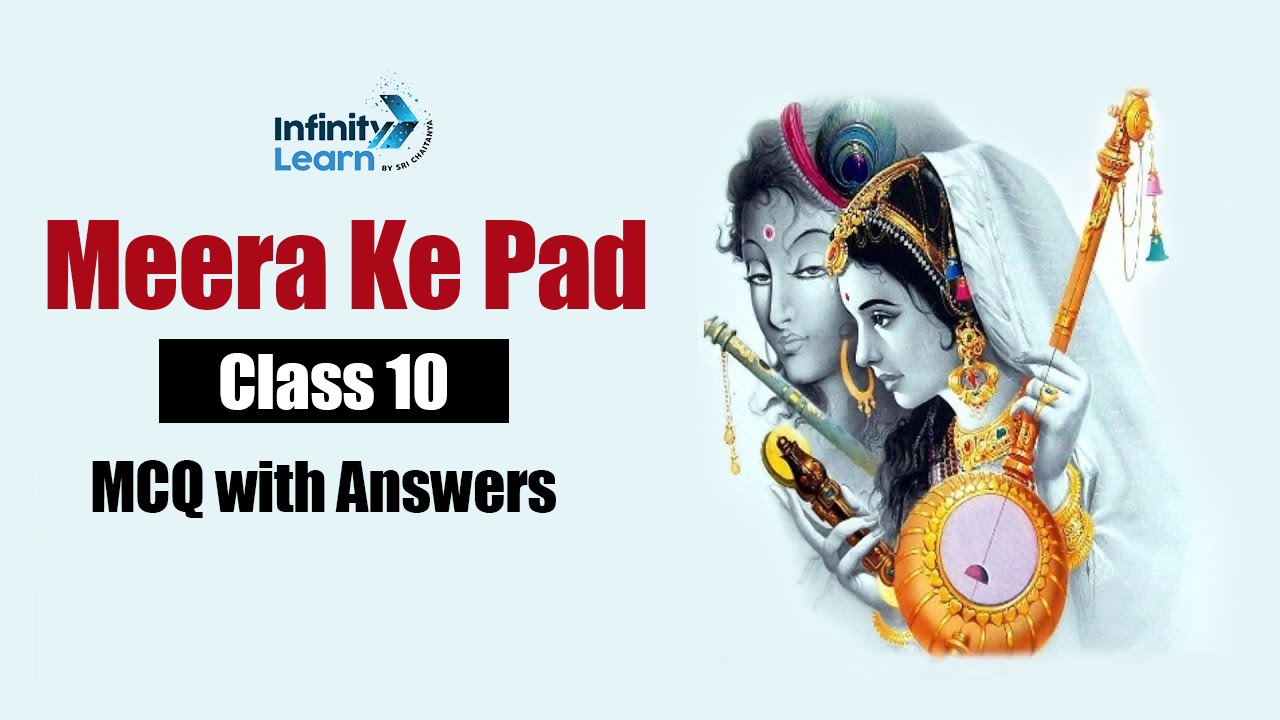Table of Contents
Meera Ke Pad Class 10 MCQ: Understanding Meera Ke Pad is essential for scoring well in the Hindi Class 10 board exams. These poetic verses by Meera Bai reflect deep devotion and spiritual wisdom, making them an important part of Hindi literature. To help students grasp the meaning, sentence structure, and grammar used in Meera Ke Pad, we have created the Meera Ke Pad Class 10 MCQ series.
This MCQ series is carefully designed to cover key aspects of sentence formation, Hindi grammar, and poetic analysis. Each multiple-choice question helps students identify important themes, understand sentence structure, and improve their Hindi language skills. By practicing these MCQs, students can avoid common mistakes, build a strong foundation in Hindi literature, and enhance their overall exam preparation.

Meera Ke Pad Class 10 MCQ – Master Hindi Poetry with Confidence
The CBSE Class 10 Hindi Exam 2025 is scheduled for February 28, 2025, and practicing Meera Ke Pad Class 10 MCQs can help students strengthen their understanding of Hindi literature. Our MCQ series follows the latest CBSE syllabus, ensuring that students get the most relevant and effective practice for their board exams.
This MCQ series is designed for all types of learners, whether you are building your basics or aiming to master advanced poetic analysis. Each multiple-choice question covers key aspects of Meera Bai’s verses, helping students improve their grammar, sentence formation, and literary comprehension. Detailed explanations are provided with every answer, allowing students to learn from mistakes and develop a deeper understanding of the text.
By regularly practicing with Meera Ke Pad Class 10 MCQs, students can boost their confidence, improve accuracy, and enhance their overall performance in the Class 10 Hindi exam 2025.
Meera Ke Pad Class 10 MCQ with Answers Chapter-Based Questions
Here are some Meera ke Pad Class 10 Question and answer for Hindi board exam preparation.
Q1. Whose darshan does Meera wish to have every morning?
a) The rising sun
b) Lord Krishna
c) Her guru
d) The river
Answer: b) Lord Krishna
Q2. What is the central theme of Meera’s poetry?
a) Material wealth
b) Devotion and love for Krishna
c) Social issues
d) Political struggles
Answer: b) Devotion and love for Krishna
Q3. How does Meera express her love for Lord Krishna in her verses?
a) By praising his physical beauty
b) By considering him her beloved and surrendering completely
c) By questioning his existence
d) By seeking worldly blessings from him
Answer: b) By considering him her beloved and surrendering completely
Q4. Which poetic emotion (Rasa) is most prominent in Meera’s poetry?
a) Veer Rasa (Heroism)
b) Bhakti Rasa (Devotion)
c) Hasya Rasa (Humor)
d) Karuna Rasa (Compassion)
Answer: b) Bhakti Rasa (Devotion)
Q5. What challenges did Meera face due to her devotion to Krishna?
a) Opposition from her royal family
b) Social criticism
c) Attempts to poison her
d) All of the above
Answer: d) All of the above
Q6. What does Meera believe is the true meaning of devotion?
a) Gaining religious recognition
b) Unconditional surrender to Krishna
c) Performing rituals for worldly benefits
d) Impressing society with religious knowledge
Answer: b) Unconditional surrender to Krishna
Q7. In Meera’s poetry, what does ‘Viraha Bhava’ (emotion of separation) signify?
a) Physical pain
b) The longing for union with Krishna
c) A desire to leave worldly responsibilities
d) A wish to gain power
Answer: b) The longing for union with Krishna
Q8. What does Meera compare her love for Krishna to?
a) A mother’s love for her child
b) A river’s flow towards the ocean
c) A bird’s longing for the sky
d) A warrior’s duty to his kingdom
Answer: b) A river’s flow towards the ocean
Q9. What message does Meera convey through her poetry?
a) True devotion transcends societal norms
b) Wealth and power lead to happiness
c) Religion should be practiced in secrecy
d) One must follow strict rituals to attain God
Answer: a) True devotion transcends societal norms
Q10. Which language style is predominantly used in Meera’s poetry?
a) Sanskrit
b) Persian
c) Braj Bhasha and Rajasthani
d) English
Answer: c) Braj Bhasha and Rajasthani
Meera Ke Pad Class 10 MCQ – Poetic Theme & Meaning
Q1. What is the central theme of Meera Bai’s poetry?
a) Devotion to Lord Krishna
b) Nature and beauty
c) Social issues
d) Patriotism
Answer: a) Devotion to Lord Krishna
Q2. Meera Bai’s poetry is primarily a form of which type of literature?
a) Epic
b) Bhakti Kavya
c) Satire
d) Romantic poetry
Answer: b) Bhakti Kavya
Q3. In Meera Bai’s verses, what does she consider Lord Krishna to be?
a) A friend
b) A king
c) Her beloved and lord
d) A guru
Answer: c) Her beloved and lord
Q4. Which of the following is NOT a major theme in Meera Bai’s poems?
a) Selfless devotion
b) Social equality
c) Political issues
d) Divine love
Answer: c) Political issues
Q5. What does Meera Bai express in her poetry?
a) Love for material wealth
b) Detachment from worldly possessions
c) Fear of society
d) Hatred for Krishna
Answer: b) Detachment from worldly possessions
Q6. Which quality of Meera Bai is reflected in her poems?
a) Humility and surrender
b) Jealousy and anger
c) Greed and arrogance
d) Fear and confusion
Answer: a) Humility and surrender
Q7. Which literary device is commonly used in Meera Bai’s poetry?
a) Simile
b) Metaphor
c) Both a and b
d) None of the above
Answer: c) Both a and b
Q8. Why is Meera Bai considered a prominent Bhakti poet?
a) Because she wrote about politics
b) Because she was a queen
c) Because of her deep devotion to Krishna
d) Because she criticized other poets
Answer: c) Because of her deep devotion to Krishna
Meera Ke Pad Class 10 MCQ – Literary Style & Techniques in Meera Ke Pad
Q9. Meera Bai’s poetry is usually written in which format?
a) Doha
b) Chaupai
c) Pad (Couplet)
d) Sonnet
Answer: c) Pad (Couplet)
Q10. What is the primary mood (Bhava) in Meera Bai’s poetry?
a) Hasya (Humor)
b) Shringar (Romance)
c) Viraha (Separation)
d) Veer (Bravery)
Answer: c) Viraha (Separation)
Q11. Which poetic technique is frequently found in Meera Bai’s poetry?
a) Symbolism
b) Personification
c) Refrain (Repeated lines)
d) All of the above
Answer: d) All of the above
Q12. What kind of rhythm does Meera Bai’s poetry follow?
a) Free verse
b) Strict meter
c) Prose-like narration
d) Completely rhymeless structure
Answer: b) Strict meter
Meera Ke Pad Class 10 MCQ – Meera Bai’s Life & Historical Context
Q13. Meera Bai belonged to which royal family?
a) Sisodia
b) Rathore
c) Maratha
d) Chauhan
Answer: b) Rathore
Q14. During which period did Meera Bai write her poetry?
a) Vedic period
b) Medieval period
c) Modern period
d) Ancient period
Answer: b) Medieval period
Q15. Which Mughal emperor was ruling during Meera Bai’s time?
a) Akbar
b) Babur
c) Aurangzeb
d) Jahangir
Answer: a) Akbar
Q16. Which religious movement was Meera Bai associated with?
a) Bhakti Movement
b) Sufi Movement
c) Renaissance Movement
d) Arya Samaj Movement
Answer: a) Bhakti Movement
Meera Ke Pad Class 10 MCQ – Important Literary Devices in Meera Ke Pad
Q17. Which poetic device does Meera Bai use when addressing Krishna as if he were present?
a) Alliteration
b) Apostrophe
c) Hyperbole
d) Paradox
Answer: b) Apostrophe
Q18. What does ‘Viraha Bhava’ mean in the context of Meera Bai’s poetry?
a) Joyful celebration
b) Spiritual separation from Krishna
c) Descriptive narration
d) Battle preparation
Answer: b) Spiritual separation from Krishna
Meera Ke Pad Class 10 MCQ – Concept of Devotion in Meera Ke Pad
Q19. What lesson does Meera Bai’s poetry teach us?
a) Love for material things
b) Complete surrender to God
c) Power and fame are important
d) Worship of multiple deities
Answer: b) Complete surrender to God
Q20. Meera Bai’s songs were later adapted into which form of traditional Indian music?
a) Carnatic music
b) Bhajans
c) Qawwali
d) Sufi songs
Answer: b) Bhajans
Q21. Why did Meera Bai leave her palace?
a) She wanted to explore other cities
b) She dedicated her life to Krishna’s devotion
c) She was forced into exile
d) She wanted to become a queen of another kingdom
Answer: b) She dedicated her life to Krishna’s devotion
Q22. What is the primary reason Meera Bai is considered a Bhakti poet?
a) She wrote about nature
b) Her poetry was centered on devotion to Lord Krishna
c) She was a royal poet
d) She wrote historical accounts
Answer: b) Her poetry was centered on devotion to Lord Krishna
Q23. Which literary device is most commonly found in Meera Bai’s poetry?
a) Irony
b) Hyperbole
c) Metaphor
d) Allegory
Answer: c) Metaphor
Q24. What is the most striking feature of Meera Bai’s language in her poetry?
a) Use of Persian words
b) Complex Sanskrit shlokas
c) Simple, heart-touching words in Rajasthani and Braj Bhasha
d) Use of English phrases
Answer: c) Simple, heart-touching words in Rajasthani and Braj Bhasha
Q25. Why did Meera Bai’s poetry become famous?
a) Because she wrote for kings
b) Due to its deep spiritual devotion and emotional appeal
c) Because it was taught in schools
d) Because she won poetry competitions
Answer: b) Due to its deep spiritual devotion and emotional appeal
Q26. Which form of Hindu devotion does Meera Bai’s poetry primarily represent?
a) Jnana Yoga
b) Karma Yoga
c) Bhakti Yoga
d) Raja Yoga
Answer: c) Bhakti Yoga
Q27. What is the impact of Meera Bai’s poetry on Indian culture?
a) It influenced Bhakti movements and devotional music
b) It introduced modern Hindi literature
c) It focused only on royal families
d) It had no impact on Indian traditions
Answer: a) It influenced Bhakti movements and devotional music









